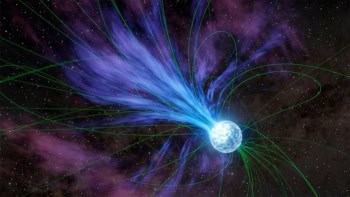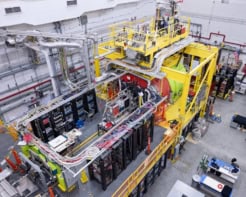
The maximum number of neutrons that can be packed into fluorine and neon isotopes have been determined by nuclear physicists working on an experiment in Japan. These are the first new measurements of the neutron dripline in 20 years and could provide physicists with important information about how to model the atomic nucleus. The same experiment failed to determine the dripline for sodium, which is the next element in the periodic table beyond neon.
The neutron dripline refers to the maximum number of neutrons that can be packed into an atomic nucleus before it becomes unbound. Until this latest work, physicists had measured the driplines of the eight lightest elements (hydrogen up to oxygen). In general, the maximum number of neutrons in a nucleus increases with the atomic number. However, there appears to be an exception to this rule with the dripline isotopes carbon-22, nitrogen-23 and oxygen-24 – which all have 16 neutrons. This is called the “oxygen anomaly” and suggests that 16 may be a magic number for neutrons, signifying the completion of a stable shell of neutrons.
Now, Deuk Soon Ahn and colleagues working on the BigRIPS experiment at the RIKEN Radioactive Isotope Beam Factory have looked at the next three elements in the periodic table: fluorine, neon and sodium.
Fragmenting nuclei
To look for the most neutron-rich isotopes of these elements, the team fired a high-energy beam of calcium-48 ions at a beryllium target. The calcium nuclei undergo fragmentation to create smaller nuclei, which were studied by the team. This was done using BigRIPS, which sorts nuclei according to their mass and charge.
Before the study was done, the heaviest known isotopes of these elements were fluorine-31, neon-34 and sodium-37. However, it was not known if heavier isotopes existed. The team was unable to detect fluorine-32, fluorine-33, neon-35 and neon-36 – providing strong evidence that fluorine-31 (with 22 neutrons) and neon-34 (with 24 neutrons) are dripline isotopes.
The team also looked for sodium-38 and sodium-39 and although they saw no evidence for sodium-38, they did spot one sodium-39 nucleus – which has 28 neutrons. As a result, they conclude that the neutron dripline must be at or beyond 28 neutrons for sodium.
These observations do not fully agree with state-of-the-art calculations of the dripline for these elements – which suggest that both fluorine and neon should have a maximum of 24 neutrons. The model of the nucleus used in these calculations will therefore have to be revised.
Looking to the future, the Facility for Rare Isotope Beams (FRIB) at Michigan State University in the US will open in 2022 with beams that are significantly more intense than those at RIKEN. This should make it possible for physicists to resolve the dripline for sodium and begin to study magnesium, which is the next element in the periodic table.
The research is described in Physical Review Letters.



